A total solar eclipse occurred at the Moon's ascending node of orbit on Thursday, May 9, 1929, with a magnitude of 1.0562. A solar eclipse occurs when the Moon passes between Earth and the Sun, thereby totally or partly obscuring the image of the Sun for a viewer on Earth. A total solar eclipse occurs when the Moon's apparent diameter is larger than the Sun's, blocking all direct sunlight, turning day into darkness. Totality occurs in a narrow path across Earth's surface, with the partial solar eclipse visible over a surrounding region thousands of kilometres wide. Totality was visible from Dutch East Indies (today's Indonesia), Federated Malay States (now belonging to Malaysia), Siam (name changed to Thailand later), French Indochina (the part now belonging to Vietnam), Spratly Islands, Philippines, and South Seas Mandate in Japan (the part now belonging to FS Micronesia).
Observations
A team of British and German scientists observed the total eclipse in Pattani province in southern Siam. King Rama VII and Queen Rambai Barni also visited the observation camp set up by foreign scientists and observed the eclipse together in Pattani. This was the last time that Siam (Thailand) received a large-scale solar eclipse observation team so far. The other teams Thailand received later, including the American team for the total solar eclipse of June 20, 1955 were much smaller.[1]
Related eclipses
Eclipses in 1929
- A total solar eclipse on May 9.
- A penumbral lunar eclipse on May 23.
- An annular solar eclipse on November 1.
- A penumbral lunar eclipse on November 17.
Metonic
- Preceded by: Solar eclipse of July 20, 1925
- Followed by: Solar eclipse of February 24, 1933
Tzolkinex
- Preceded by: Solar eclipse of March 28, 1922
- Followed by: Solar eclipse of June 19, 1936
Half-Saros
- Preceded by: Lunar eclipse of May 3, 1920
- Followed by: Lunar eclipse of May 14, 1938
Tritos
- Preceded by: Solar eclipse of June 8, 1918
- Followed by: Solar eclipse of April 7, 1940
Solar Saros 127
- Preceded by: Solar eclipse of April 28, 1911
- Followed by: Solar eclipse of May 20, 1947
Inex
- Preceded by: Solar eclipse of May 28, 1900
- Followed by: Solar eclipse of April 19, 1958
Triad
- Preceded by: Solar eclipse of July 8, 1842
- Followed by: Solar eclipse of March 9, 2016
Solar eclipses of 1928–1931
This eclipse is a member of a semester series. An eclipse in a semester series of solar eclipses repeats approximately every 177 days and 4 hours (a semester) at alternating nodes of the Moon's orbit.[2]
The partial solar eclipse on June 17, 1928 occurs in the previous lunar year eclipse set, and the partial solar eclipse on September 12, 1931 occurs in the next lunar year eclipse set.
| Solar eclipse series sets from 1928 to 1931 | ||||||
|---|---|---|---|---|---|---|
| Ascending node | Descending node | |||||
| Saros | Map | Gamma | Saros | Map | Gamma | |
| 117 | May 19, 1928 Total (non-central) |
1.0048 | 122 | November 12, 1928 Partial |
1.0861 | |
| 127 | May 9, 1929 Total |
−0.2887 | 132 | November 1, 1929 Annular |
0.3514 | |
| 137 | April 28, 1930 Hybrid |
0.473 | 142 | October 21, 1930 Total |
−0.3804 | |
| 147 | April 18, 1931 Partial |
1.2643 | 152 | October 11, 1931 Partial |
−1.0607 | |
Saros 127
This eclipse is a part of Saros series 127, repeating every 18 years, 11 days, and containing 82 events. The series started with a partial solar eclipse on October 10, 991 AD. It contains total eclipses from May 14, 1352 through August 15, 2091. There are no annular or hybrid eclipses in this set. The series ends at member 82 as a partial eclipse on March 21, 2452. Its eclipses are tabulated in three columns; every third eclipse in the same column is one exeligmos apart, so they all cast shadows over approximately the same parts of the Earth.
The longest duration of totality was produced by member 31 at 5 minutes, 40 seconds on August 30, 1532. All eclipses in this series occur at the Moon’s ascending node of orbit.[3]
| Series members 46–68 occur between 1801 and 2200: | ||
|---|---|---|
| 46 | 47 | 48 |
 February 21, 1803 |
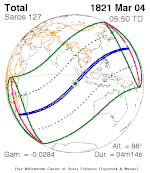 March 4, 1821 |
 March 15, 1839 |
| 49 | 50 | 51 |
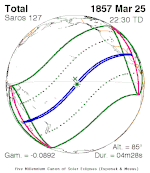 March 25, 1857 |
 April 6, 1875 |
 April 16, 1893 |
| 52 | 53 | 54 |
 April 28, 1911 |
 May 9, 1929 |
 May 20, 1947 |
| 55 | 56 | 57 |
 May 30, 1965 |
 June 11, 1983 |
 June 21, 2001 |
| 58 | 59 | 60 |
 July 2, 2019 |
 July 13, 2037 |
 July 24, 2055 |
| 61 | 62 | 63 |
 August 3, 2073 |
 August 15, 2091 |
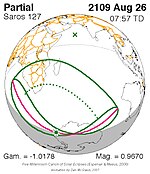 August 26, 2109 |
| 64 | 65 | 66 |
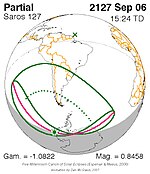 September 6, 2127 |
 September 16, 2145 |
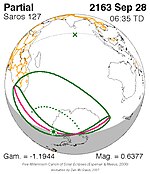 September 28, 2163 |
| 67 | 68 | |
 October 8, 2181 |
 October 19, 2199 | |
Metonic series
The metonic series repeats eclipses every 19 years (6939.69 days), lasting about 5 cycles. Eclipses occur in nearly the same calendar date. In addition, the octon subseries repeats 1/5 of that or every 3.8 years (1387.94 days). All eclipses in this table occur at the Moon's ascending node.
| 22 eclipse events between December 13, 1898 and July 20, 1982 | ||||
|---|---|---|---|---|
| December 13–14 | October 1–2 | July 20–21 | May 9 | February 24–25 |
| 111 | 113 | 115 | 117 | 119 |
 December 13, 1898 |
 July 21, 1906 |
 May 9, 1910 |
 February 25, 1914 | |
| 121 | 123 | 125 | 127 | 129 |
 December 14, 1917 |
 October 1, 1921 |
 July 20, 1925 |
 May 9, 1929 |
 February 24, 1933 |
| 131 | 133 | 135 | 137 | 139 |
 December 13, 1936 |
 October 1, 1940 |
 July 20, 1944 |
 May 9, 1948 |
 February 25, 1952 |
| 141 | 143 | 145 | 147 | 149 |
 December 14, 1955 |
 October 2, 1959 |
 July 20, 1963 |
 May 9, 1967 |
 February 25, 1971 |
| 151 | 153 | 155 | ||
 December 13, 1974 |
 October 2, 1978 |
 July 20, 1982 | ||
Tritos series
This eclipse is a part of a tritos cycle, repeating at alternating nodes every 135 synodic months (≈ 3986.63 days, or 11 years minus 1 month). Their appearance and longitude are irregular due to a lack of synchronization with the anomalistic month (period of perigee), but groupings of 3 tritos cycles (≈ 33 years minus 3 months) come close (≈ 434.044 anomalistic months), so eclipses are similar in these groupings.
| Series members between 1801 and 2200 | ||||
|---|---|---|---|---|
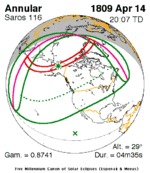 April 14, 1809 (Saros 116) |
 March 14, 1820 (Saros 117) |
 February 12, 1831 (Saros 118) |
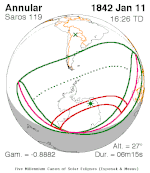 January 11, 1842 (Saros 119) |
 December 11, 1852 (Saros 120) |
 November 11, 1863 (Saros 121) |
 October 10, 1874 (Saros 122) |
 September 8, 1885 (Saros 123) |
 August 9, 1896 (Saros 124) |
 July 10, 1907 (Saros 125) |
 June 8, 1918 (Saros 126) |
 May 9, 1929 (Saros 127) |
 April 7, 1940 (Saros 128) |
 March 7, 1951 (Saros 129) |
 February 5, 1962 (Saros 130) |
 January 4, 1973 (Saros 131) |
 December 4, 1983 (Saros 132) |
 November 3, 1994 (Saros 133) |
 October 3, 2005 (Saros 134) |
 September 1, 2016 (Saros 135) |
 August 2, 2027 (Saros 136) |
 July 2, 2038 (Saros 137) |
 May 31, 2049 (Saros 138) |
 April 30, 2060 (Saros 139) |
 March 31, 2071 (Saros 140) |
 February 27, 2082 (Saros 141) |
 January 27, 2093 (Saros 142) |
 December 29, 2103 (Saros 143) |
 November 27, 2114 (Saros 144) |
 October 26, 2125 (Saros 145) |
 September 26, 2136 (Saros 146) |
 August 26, 2147 (Saros 147) |
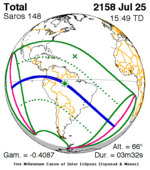 July 25, 2158 (Saros 148) |
 June 25, 2169 (Saros 149) |
 May 24, 2180 (Saros 150) |
 April 23, 2191 (Saros 151) | ||||
Inex series
This eclipse is a part of the long period inex cycle, repeating at alternating nodes, every 358 synodic months (≈ 10,571.95 days, or 29 years minus 20 days). Their appearance and longitude are irregular due to a lack of synchronization with the anomalistic month (period of perigee). However, groupings of 3 inex cycles (≈ 87 years minus 2 months) comes close (≈ 1,151.02 anomalistic months), so eclipses are similar in these groupings.
| Series members between 1801 and 2200 | ||
|---|---|---|
 July 27, 1813 (Saros 123) |
 July 8, 1842 (Saros 124) |
 June 18, 1871 (Saros 125) |
 May 28, 1900 (Saros 126) |
 May 9, 1929 (Saros 127) |
 April 19, 1958 (Saros 128) |
 March 29, 1987 (Saros 129) |
 March 9, 2016 (Saros 130) |
 February 16, 2045 (Saros 131) |
 January 27, 2074 (Saros 132) |
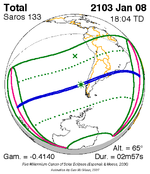 January 8, 2103 (Saros 133) |
 December 19, 2131 (Saros 134) |
 November 27, 2160 (Saros 135) |
 November 8, 2189 (Saros 136) |
|
References
- ^ "SOLAR ECLIPSES IN SIAM (THAILAND)". National Astronomical Research Institute of Thailand. Archived from the original on 30 March 2016.
- ^ van Gent, R.H. "Solar- and Lunar-Eclipse Predictions from Antiquity to the Present". A Catalogue of Eclipse Cycles. Utrecht University. Retrieved 6 October 2018.
- ^ "NASA - Catalog of Solar Eclipses of Saros 127". eclipse.gsfc.nasa.gov.





Recent Comments